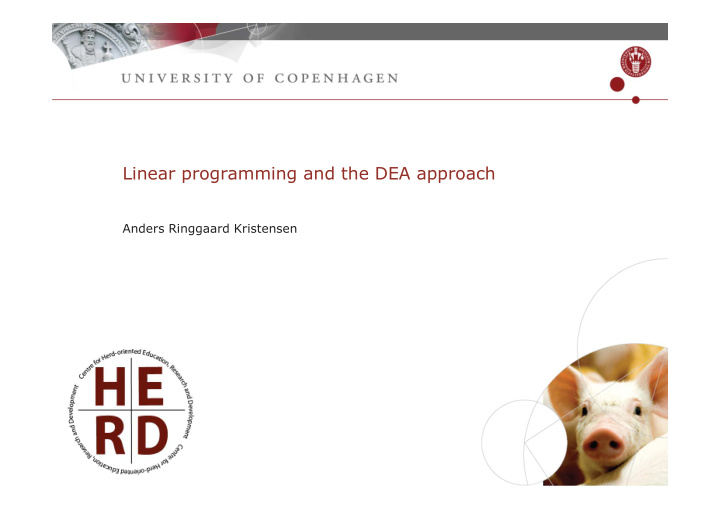



Linear programming and the DEA approach Anders Ringgaard Kristensen
Absolute effectiveness Let • Y be a vector of products • x be a vector of factors • U( x , Y ) be the utility function of a farmer • T be the set of technically possible combinations of factors and products for the farm in question. How efficient is the farmer if his current situation is described by the product-factor combination ( x i , Y i )? His absolute effectiveness is defined as If U is unknown the absolute effectiveness may not be calculated
Absolute efficiency If the utility function U is unknown, we may instead calculate the absolute efficiency, F i , (where the ideal is to produce as much as possible with as little as possible) as An absolute efficiency of F i = 1.0 indicates that the current input x i could not result in higher output than Y i . A value of F i > 1.0 means that more output could have been produced with the same input. Calculation of the absolute efficiency requires that T is known.
Relative efficiency If the set T is unknown, it may be estimated as T * based on data from other farms. If i = 1, … , 100, any observation of ( x i , Y i ) is a valid member of T If we have enough observations (farms) we may estimate T as T * We then define the relative efficiency as
Relative efficiency, sow herd, one factor, one product
Graphical illustration: Constant returns to scale
Solved by linear programming
Graphical illustration: Variable returns to scale
Solved by linear programming
One factor, two products
How relative efficient is farmer i ? His input-output combination is ( x i , Y i ) We have J other farms with input-output combinations ( x j , Y j ), j = 1, … , J. Let λ 1 , … , λ J be weighting factors so that • ∑ j λ j = 1 • λ 1 , … , λ J ≥ 0 Then ∑ j x j λ j is a weighted average of inputs And ∑ j Y j λ j is a weighted average of outputs using the same weighting factors. Assume that x i ≥ ∑ j x j λ j We will then determine F in such a way that FY i ≥ ∑ j Y j λ j If it is necessary to multiply Y i by a factor F > 1 it means that other farms produce more efficient than farm i. We want the weighting λ 1 , … , λ J that maximizes F
A linear programming problem The variables of the problem: F, λ 1 , … , λ J The coefficients: x 1 , … , x J , Y 1 , … , Y J The objective function: • F = Max! The constraints: • x i ≥ ∑ j x j λ j • FY i ≤ ∑ j Y j λ j • ∑ j λ j = 1 • λ 1 , … , λ J ≥ 0
Recommend
More recommend